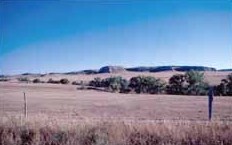Signal Butte | |
 Signal Butte | |
| Nearest city | Gering, Nebraska |
|---|---|
| Coordinates | 41°47′50″N103°54′24″W / 41.79722°N 103.90667°W |
| NRHP reference No. | 66000452 |
| Significant dates | |
| Added to NRHP | October 15, 1966 [1] |
| Designated NHL | January 20, 1961 [2] |
Signal Butte is a major prehistoric archaeological site in rural western Nebraska, United States. Designated by the Smithsonian trinomial 25SF1, it was one of the first pre-contact Native American sites to be formally investigated in the central plains. The archaeological sites are located atop the eponymous butte west of Robidoux Pass and Gering, Nebraska. It was declared a National Historic Landmark in 1961. [2] The site is not open to the public.

